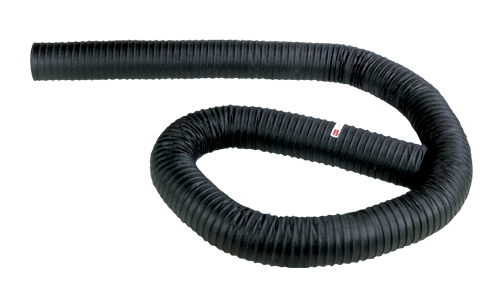

Industrial duct systems are used for supply and exhaust in a wide range of industrial settings. These systems vary widely depending on their intended purpose. They can be made from fabric, metal, or plastic and may be held together using flanges, clamps, welds, slip fits, or some combination thereof. Some systems may be mostly straight, while others may contain complex transitions, elbows, supports and hangers, discharge outlets, and more.
HVAC installers are more frequently turning to flexible ducts made from PVC or fabric to address the challenges posed by industrial applications.
Flexible Industrial Duct Advantages
Whatever the purpose and setup, industrial duct systems must be able to withstand the demanding conditions typically found in industrial applications. Flexible industrial ducts offer numerous benefits, such as:
- Durability. Flexible industrial ducts are available that can resist the durability challenges of nearly any industrial situation.
- Affordability. Made from fabric or polymer, flexible industrial ducts are more affordable than most fabricated metal duct solutions.
- Mobility. Flexible ducts are lightweight, which makes them significantly easier to move or reroute when necessary compared to more traditional ducting solutions.
- Versatility. Flexible ductwork is easy to contort and maneuver into hard-to-reach areas.
Applications
Common applications for flexible industrial ducts include:
- Air ventilation
- Solid waste handling
- Industrial exhaust
- High temperature ventilation
- Abrasives transfer applications
Non-Metallic, Flexible Duct Types
At Fournier Rubber, we offer numerous non-metallic and flexible duct solutions, ensuring that we have a solution to meet any application need. Material composition should be a primary consideration when trying to determine which duct will perform best in each situation.
Some materials are better suited for certain applications than others.
For example, ducting for an application that involves extremely high temperatures often requires a silicone duct, since silicone tolerates extreme temperatures better than PVC or a neoprene-coated fabric.
Fabrics
- Neoprene-coated: Heavy dust applications
Plastics
- PVC: Light dust, air movement, chemical resistance applications
- Urethane: Material handling and abrasives transfer applications
- Silicone: Industrial exhaust, high-temperature applications
- Thermoplastic/fiberglass-reinforced plastic (FRP): Abrasives transfer applications
Industrial Ducting Capabilities
Industrial ducting solutions are available to meet a wide range of capability needs, such as:
- General service. Industrial ducting is extremely lightweight, flexible, and economical. It is often used for air and dust control in general service applications.
- Medium service. Medium-service applications such as light-duty material handling, plant cleanup, fume control, and air transfer can rely on medium-weight flexible ducting.
- Heavy-duty service. Abrasion-resistant flexible ducting is ideal for many heavy duty industrial applications where rugged or harsh operating conditions may damage standard metal ducts.
- Extruded material handling. Flexible ducting offers an economical alternative to rubber hoses in the extruded material handling process.
- Garage exhaust/indoor fume control. Silicone-coated flexible ducting facilitates stationary-to-constant flexing in exhaust and fume extraction systems used in garages and manufacturing environments.
- Medium-duty fume control. Industrial ducting performs well in medium-duty fume control settings, easily managing industrial chemical fumes.
- Special fume control. Some fume control applications are very demanding. In these cases, ultra-high-performance industrial ducting materials are used for superior fume control.
- Welding exhaust/utility blower ducts. Industrial ducting can be used to carry large volumes of warm or cold air
- Ultra-high temperature. Flexible ducting solutions are available that can withstand temperatures as high as 1800 °F.
- Specialty meat tubing/high-temp fume control. Airtight seams and added strength make flexible industrial ducting ideal in specialty meat tubing and high-temp fume control settings.
- Food-grade. Food, pharmaceutical, and material transfer applications can integrate industrial duct systems to simplify workflow and boost productivity.
- Temperature loss protection. Insulated flexible ducting can help to prevent heating or cooling loss in temperature-controlled applications.
About Fournier Rubber & Supply’s Industrial Duct Systems
Industrial duct systems play a key role in the transfer of liquids and gasses throughout a variety of industries and applications. Each segment of flexible plastic tubing boasts unique properties that determine which environments they are best suited for.
At Fournier Rubber & Supply Company, we’ve been supplying clients with tubing products since 1933. Our trained customer service team is eager to assist you with selecting the ideal flexible tubing for your individualized application. Visit our About Us page to learn more about us or request a quote for an upcoming project to see how we can help.
Dura-Vent Products
- Blue-Max
- Dura-Flex
- Dura-Thane
- Econo-Max
- Flexfast Couplings
- Flexflyte®
- Max-Flyte
- TD-S/TD-HS
- Therma-Cool
- Vac-U-flex®
- Vac-U-lok®
Ducting Materials
- Food Grade Urethane
- Neoprene Coated Nylon
- Polyester
- PVC
- Silicone
- Thermal Wrap-Mylar
- Thermoplastic Rubber
- Urethane
Related Products
- Clamps
- Extruded Cuffs
- Screw on Cuffs
Ducting Applications
- Abrasive Particles
- Aviation
- Blower and Fan
- Duct Cleaning
- Fume Removal
- Garage Exhaust
- High Temperature
- Lavoratory Waste
- Leaf Collection
- Light Air And Dust
- Pharmaceutical
- Sawdust Recovery
- Street Cleaning
- Vacuum
- Woodchip Recovery
Thermoid Products
- Mil Spec Ducting
- VP-2 Ducting






